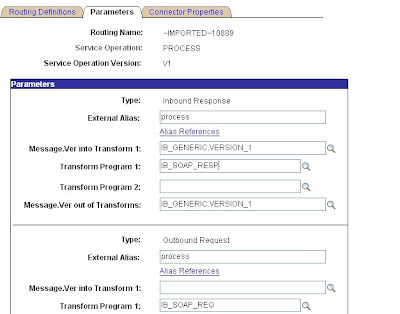BPEL processes in PeopleSoft Applications using Peopletools 8.48 (and later)
In 2005, when I was the Enterprise Architect of Peopletools (a development and runtime platform of Peoplesoft Applications), one of the important projects we did was to add many features to enable SOA in a better way. Peopletools 8.48 provided a better Service designer to consume or provide webservices. Many new features like WS-Addressing support, WS-SE, etc aligned Peopletools 8.48 to seamlessly work with BPEL. A much better than earlier version of Peopletools 8.46 and 8.47! (both these version are also certified with BPEL 10.1.2).
Many additional features like a support to WS-A headers & correlation id, security credentials, WSIL lookup, and others, allow PeopleSoft Applications and BPEL to discover each other’s services and invoke them other synchronously or asynchronously in a secured way.
We also added some features specifically for BPEL e.g. Partnerlinks in generated WSDLs, a utility Application classes, BPELUtil, IBUtil etc. With partnerlink support, the PeopleSoft Services are easier for BPEL to consume.
Using newly introduced BPELUtil, Peoplecode developers can directly launch a BPEL process. IBUtil class provides APIs to track the process. It also provides some more utility methods to get BPEL console URL, domain, etc. In fact, Peoplesoft CRM developed a process monitor for CRM processes using these APIs in release 9.0. Additionally, BPEL console can be launched within Peoplesoft portal without re-login.
Consuming a BPEL process was made very easy in Peopletools. One can consume the service by discovering from BPEL’s WSIL, UDDI, or directly importing using wsdl URL, or from a WSDL file. A copy of the WSDL is stored in WSDL repository table. Using the service designer, the developer can select port type, operations and messages. The developer can also add some handlers and routings.
Easy Coding: The consumed BPEL process can be launched (invoked) using a very few Peoplecode statements.
Creating a Message
&payload = CreateXmlDoc(&customer);
&msg = CreateMessage(Operation.PROCESS, %IntBroker_Request);
&msg.SetXmlDoc(&payload);
Invoking a BPEL process
&response = &bpelProcess.LaunchSyncBPELProcess(&OPERATION, &msg, "", "");
Processing a response
If All(&response) Then
&responseString = &response.GenXMLString();
WinMessage(&responseString);
Else
WinMessage("Error: No reply ");
Providing Services:
Peoplesoft Component Interfaces (CI)s and Peoplecode App Classes can be easily exposed as web services. The Service Designer helps to assemble the service by defining service operations and map them one or more CIs or App Classes or Peoplecode functions (handlers). Using the Schema designer one can design Peoplsoft’s rowset or non-rowset based message or import pure XML message as a schema. The service designer abstracts the internal names of handlers and messages allowing developers to give appropriate names. After assembling a service, the developer can publish the service as a WSDL to a WSIL or UDDI repository. The WSDL is also saved in an internal WSDL repository and available for query or export.
Routing and transformations:
Many times the external service may expect or send a message, which could be different than the internal message. The Service designer allows developing and using transformations of these messages using a graphical mapper.
Peopletools supports following Request Response Patterns:
- One way notification (Fire and Forget)
- Synchronous Request Response
- Asynchronous Request Response
The Async Request response is supported using WS-Addressing headers. The external WS-Addressing headers, like correlation message id, propagated to Peoplecode based application (via IBInfo).
Security: In the world of integrations, Security is very important. Different framework handles security differently. PT8.48 implements a waterfall security model. A Username token and pass code token can be set at Service operation or Node or may have a default. It can be sent encrypted, digitally signed or text. An application programmer can override these using Security override API to provide a different token. This security credentials are sent via WS-SE.
Using the Integration framework, Enterprise Applications like CRM, HCM developed many Business Processes with BPEL.
(Peoplesoft is a Trademark of Oracle Corp. To differentiate with other ERP applications offered by Oracle, I am specifically using Peoplesoft name.)
Labels: BPEL, Peoplesoft, Peopletools8.48, RESTful Webservices, SOA



